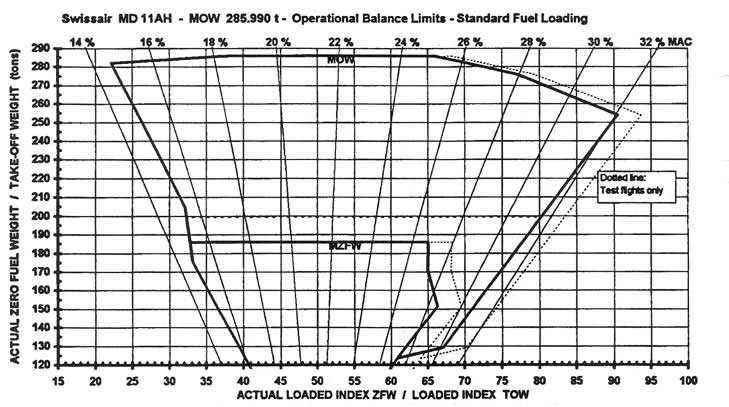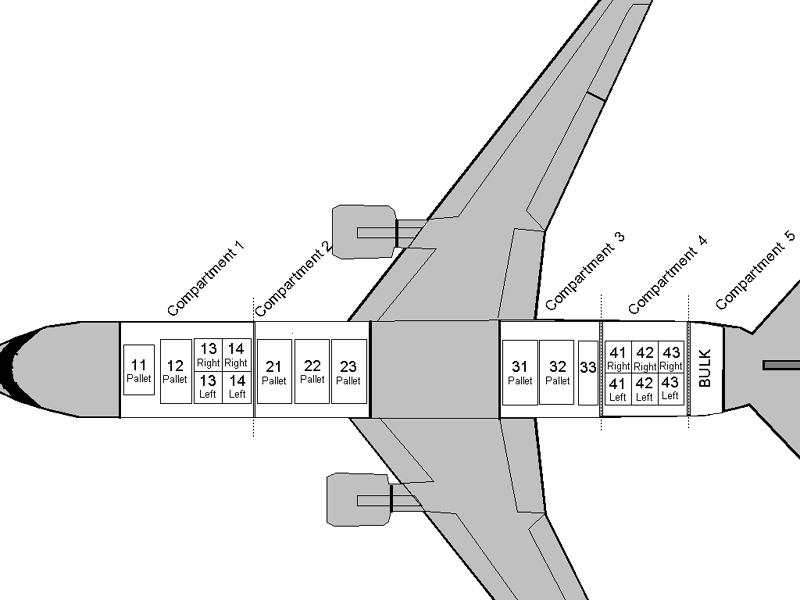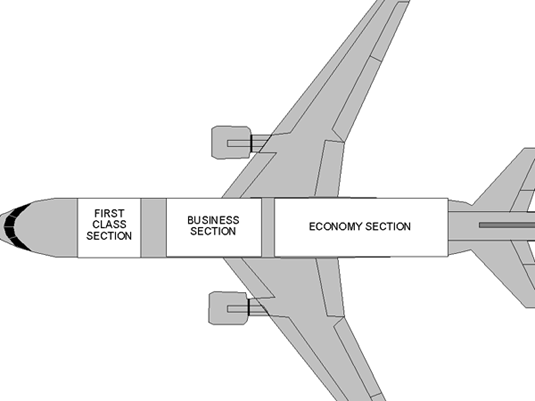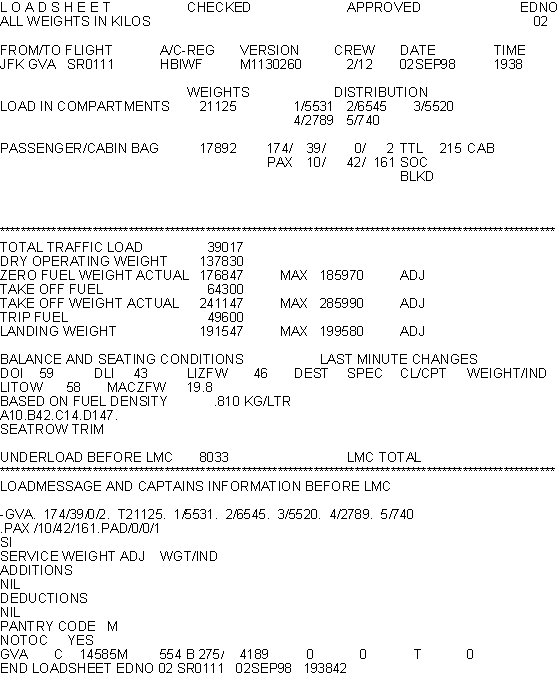Associated links (A98H0003)
Weight and balance
Weight and balance limitations
Weight limitations
HB-IWF (the occurrence aircraft) was to be operated within the following weight limits:
| Item | Weight (kg) |
|---|---|
| Maximum taxi weight | 287 120 |
| Maximum TOW | 285 990 |
| Maximum landing weight | 199 580 |
| Maximum ZFW | 185 970 |
| Maximum in-flight landing flaps weightFootnote 1 | 200 940 |
Balance limitations
The C of G limits given in the load index below are valid up to the maximum TOW with landing gear extended.
Lateral loading is restricted by a maximum unsymmetrical fuel load of 1 800 kg.
Cargo compartment limits
The MD-11 has five cargo compartments. The configuration used for SR 111 is Swissair unit load version 260, depicted below.
| Forward compartment | Aft compartment | ||||
|---|---|---|---|---|---|
| 1 | 2 | 3 | 4 | 5 | |
| Station location | 506 812 1103 | 1521 1775 1964 2090 | |||
| Maximum capacity (kg) | 11 104 | 15 443 | 13 480 | 6 768 | 3 402 |
| 25 401 | 15 876 | ||||
Aircraft empty weights
Structure weight
Swissair defines the structure weight as the weight of the aircraft including furnishings and loose equipment.
Basic empty weight
Swissair defines the basic empty weight as the combined structure weight and standard fluid weights.
The basic empty weight for HB-IWF (the occurrence aircraft) was as follows:
| Item | Weight (kg) |
|---|---|
| Structure weight | 129 701.7 |
| Water | 952 |
| Hydraulic fluid | 179 |
| Engine lubricating oil | 137 |
| Unuseable fuel in tank | 562 |
| Unuseable fuel in lines | 276 |
| Standard fluid weight | 2 106.0 |
| Basic empty weight | 131 807.7 |
Basic weight
Swissair's weight control system uses average basic weights for groups of the same aircraft type and configuration. HB-IWF was in the 131 925 kg basic weight group.
Dry operating wWeight
Swissair defines the dry operating weight as the basic weight plus operational items, including crew members, their baggage, and pantry items (e.g., galley, bar, food, and beverages). Swissair uses standard weights for crew members (90 kg each); the pantry weight is based on the style of pantry. SR 111 had 14 crew members and pantry code M.
The dry operating weight for HB-IWF was as follows:
| Item | Weight (kg) |
|---|---|
| Basic weight | 131 925 |
| 14 Crew members (90 kg each) | 1 260 |
| Pantry M | 4 645 |
| Dry operating weight | 137 830 |
Cargo weight and allocation
The following cargo weights and allocations for SR 111 were provided by Swissair and verified during the investigation based on collected waybills.
| Compartment | Position | Cargo / Baggage weight (kg) (includes container weight) |
|
|---|---|---|---|
| Load planner calculations | Investigation findings | ||
| 1 | 11 | 1 430 | 1 430 |
| 12 | 790 | 804 | |
| 13L | 1 065 | 1 064 | |
| 13R | 642 | 642 | |
| 14L | 870 | 870 | |
| 14R | 734 | 734 | |
| Subtotal | 5 531 | 5 544 | |
| 2 | 21 | 1 355 | 1 372 |
| 22 | 2 185 | 2 162 | |
| 23 | 3 005 | 3 007 | |
| Subtotal | 6 545 | 6 541 | |
| 3 | 31 | 2 850 | 2 766 |
| 32 | 1 920 | 1 829 | |
| 33 | 750 | 714 | |
| Subtotal | 5 520 | 5 309 | |
| 4 | 41L | 360 | 360 |
| 41R | 292 | 292 | |
| 42L | 411 | 411 | |
| 42R | 819 | 819 | |
| 43L | 258 | 258 | |
| 43R | 649 | 649 | |
| Subtotal | 2 789 | 2 789 | |
| 5 (Bulk) | 740 | 744 | |
| Grand total | 21 125 | 20 927 | |
Passenger weight and allocation
The tables below detail the number of passengers assigned seats in each section, the distribution of passengers by gender and age, and standard passenger weights used in load calculations.
| Passengers by section | Passengers by genderFootnote 2 | ||
|---|---|---|---|
| First class | 10 | Male | 174 |
| Business class | 42 | Female | 39 |
| Economy class | 161Footnote 3 | ||
| Total | 213 | Total | 213 |
| Passengers by gender | Passengers by age | ||
|---|---|---|---|
| Male | 125 | Adults (12+) | 210 |
| Female | 90 | Children (2–12) | 3 |
| Infants (<2) | 2 | ||
| Total | 215 | Total | 215 |
| Passenger | Weight (kg) |
|---|---|
| Adults (12+) | 84 |
| Children (2–12) | 35 |
| Infants (<2) | 0 |
| Crew members | 90 |
Fuel weight and allocation
Allied Fuels fuelled the aircraft with Jet-A fuel while it was parked at the gate at 2340. The total fuel weight was as follows:
| Tank | Weight (kg) |
|---|---|
| Tank 1 | 18 450 |
| Tank 2 | 27 550 |
| Tank 3 | 18 350 |
| Upper Aux | 850 |
| Tail | 100 |
| Total | 65 300 |
The flight plan indicated that SR 111 would use 1 000 kg of fuel for taxi and 49 600 kg for the trip. The actual taxi fuel used, as recorded on the FDR, was 720 kg. The take-off fuel was estimated at 64 300 kg. The aircraft taxied with a total fuel load of 65 300 kg. A fuel density of 0.812 kg/L was used for SR 111 weight and balance calculations.
Aircraft loading procedure
Passenger boarding procedure
- When a passenger purchases a ticket for a flight, their personal information is recorded in the airline's reservation system, including whether the passenger is male, female, a child, or travelling with an infant.
- When the passenger checks in for the flight, the passenger is issued a boarding pass and assigned a seat.
- The passenger's seat number and weight category information (i.e., male, female, child, infant) is electronically transferred to the load planner's electronic worksheet.
Cargo loading procedure
- Approximately two hours before the aircraft is loaded with cargo, containers, or bulk (i.e., loose items), the load planner completes a preliminary plan for loading.
- Once the aircraft is ready to be loaded, the load planner provides the ramp personnel with a loading instruction sheet.
- Once the aircraft is loaded, the ramp personnel advise the load planner of the actual loaded positions of the containers and the number of bulk items.
Load sheets
- During the cockpit preparation, the flight crew inserts the flight plan and preliminary load sheet figures into the FMS to get a complete flight plan calculation.
- The load planner inputs the data from the ramp personnel into the load control computer. The computer automatically calculates the C of G and operational weights for take-off based on the aircraft weight, the cargo weight, the passenger weight, and the fuel weight.
- Prior to pushback, the flight crew receives a printed final load sheet from the load planner via the ACARS.
- The flight crew examines the final load sheet and inputs the ZFW and the MACZFW C of G into the fuel initialization page of the aircraft's FMS using the MCDU. The actual TOW and the actual take-off C of G is then calculated by the FMS.
HB-IWF weight and balance calculations summary
Weight calculation
The information provided by Swissair indicated that the actual dry operating weight was 137 713 kg. The cargo weight was calculated by Swissair as 21 125 kg. Calculations performed during the investigation indicated that the total weight of the cargo, including passenger baggage as determined by waybills and standard weights, was 20 927 kg. While the 198 kg difference in cargo weight could not be resolved using the waybills provided, this difference represents less than 0.1% of the TOW. From an aircraft loading standpoint, this difference is negligible. Swissair calculated the passenger weight by multiplying the standard weight of 84 kg by the total number of passengers, excluding infants. Calculations performed during the investigation determined the following weights:
| Item | Weight (kg) |
|---|---|
| Dry operating weight | 137 713 |
| Cargo weight | 20 927 |
| Passenger weight | 17 892 |
| ZFW | 176 649 |
| Fuel weight | 65 300 |
| Taxi fuel | −720 |
| Gross TOW | 241 112 |
The load control computer calculated the estimated TOW of SR 111 to be 241 147 kg. A detailed calculation performed after the occurrence revealed that the actual TOW was 241 112 kg. The 35 kg difference is negligible. Both weights are within the maximum structural limits.
Balance calculation
The load control computer calculated the C of G to be 19.8% MAC. Using the balance table, the C of G was manually calculated to be 20.0% MAC. Both of these figures are well within the balance limits.



